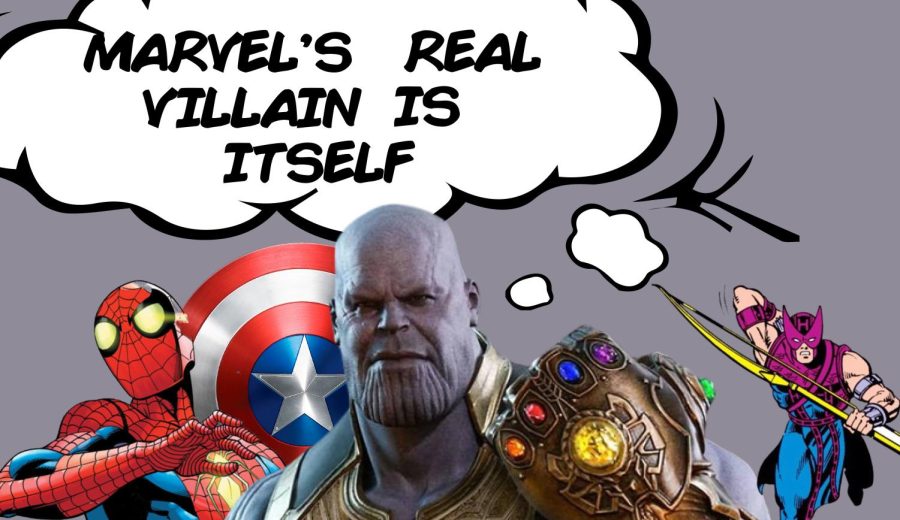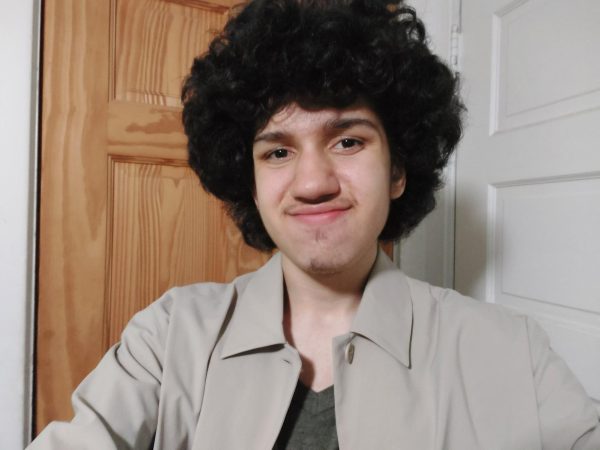An Avengers Level Threat: The MCU Has Lost Its Creative Spark
Marvel has been the studio behind many beloved franchises, characters, and stories. So why do their recent releases feel so lackluster?
January 6, 2023
Marvel as a company has thrived since the release of 2008’s “Iron Man.” Unfortunately, for years, the cinematic studi has gotten complacent with the lackluster quality of these movies that never differentiate themselves. One movie after another exhausts the viewer, who starts to lose an understanding of what makes each Marvel movie notable from the others.
The Marvel Cinematic Universe (the MCU) has lost all ideas about what makes a character diverse in its writing. Ever since the release of “Age of Ultron,” the MCU has used comedy as a crutch. Characters such as Captain America and Iron Man have incredibly serious moments in their movies, but Marvel fails to let the characters be serious throughout the movie because they don’t want to take valuable screen time away from the comedy.
For example, in Marvel’s “Avengers: Infinity War,” the main villain of this story, Thanos, preaches about the dwindling resources of the world and how he could use the Infinity Gauntlet to bring back those resources. This plot mirrors our real world, our dwindling resources, and the little time we have left to save this world. However, this story quickly is derailed by the movie’s excessive amount of comedy, which changes the tone from a story of the dangers of overpopulation and dwindling resources to a Saturday night cartoon with time travel.
Another example of this is in the recent “Thor: Love and Thunder.” There is an excessive amount of comedy that doesn’t give time for the world to be fully explained, confusing the viewer. It bloats the story to meet Marvel’s artificial standards, failing to adapt the original comic’s philosophical debates about Thor truly gripping the loss of Mjolnir.
The problem of comedy overtaking the chance to have interesting plots and characters is everywhere. Side characters like Luis and Goliath in the “Ant-Man” movies are often relegated to exposition dumps and telling jokes. Most of the side Avengers like Falcon, Black Widow, and War Machine are just there to be funny because Marvel is unwilling to allow them to be complex characters in their own way. When Hawkeye gets his own TV show, he completely changes his character from comedic relief with an ounce of depth to a more stoic and serious character.
On the other hand, the Marvel comics themselves do have the ability to use comedy well where needed. Marvel comics integrate comedy well in the Spider-Man comics. Peter uses comedy as a mask, which separates Peter from himself to take on the Spider-Man persona and become someone he is not. Peter’s mask of comedy provides both narrative and thematic relevance, while the Marvel movies just use comedy for entertainment, disrupting their flow and tone.
Also, Marvel’s lack of variation in morality makes many of the characters, especially the villains, feel unnecessary. Characters like Mysterio and Killmonger are wonderfully written with notable arcs that explain their philosophical ideas about the world; however, many other villains, such as Ultron and Mordo, merely antagonize the heroes physically, not philosophically. The heroes and villains seldom second-guess if they are in the right and they never try going about their actions in a different way to prove they have changed morally. The characters just repeat their actions because they were told that they were in the right. Often, morally gray villains in the MCU choose the option to be evil without considering the route of good. They do not consider that the plan they make is ineffective, which causes their descent into villainy unrealistic.
Furthermore, the uninspired visuals are overused to the point where it seems to be the de facto option. The world and the characters of the MCU are as bland as the Sahara desert and the environments almost exclusively use 1 or 2 colors consisting of grays and browns. The world reflects the equally bland Pseudo-military style of the MCU’s costume design. The corporate look strips away all individual and thematic differences.
For example, Spider-Man’s brightly colored outfits in the comics contrast with his newer renditions in the MCU (excluding the red and blue one from “No Way Home”). The black and maroons of Spider-man’s suit are ill-suited to represent his infectious optimism, making him more menace than friend. Although, the movies do closely follow some of the characteristics in both visual and costume designs, such as Captain America’s movies blending the darker tones of the movie with the darker colors of his suit and Iron Man’s costumes matching the high-tech but grounded aesthetics of the movies, making the themes and characters integrated into this world.
The diminishing quality of the CGI in the MCU breaks the immersion of the world just for low-quality visuals that don’t supply the narrative purpose. This is most evident in “Wandavison” during the final episode. The show’s sitcom-mystery style is destroyed by the mind-numbing laser fight, which also clashes with the show’s tone, losing the direction and inspiration with mediocre visuals.
Marvel’s abysmal decisions regarding the lack of variation in many aspects of the series make fans continue to lose faith and interest in the franchise, with some even saying that the whole cinematic universe should have ended at “Avengers: Endgame.”If Marvel does not decide to change the way it is doing things, the quality of its movies will continue to drop drastically. This new age of Marvel is bound to fall into the same pitfalls we’ve seen time after time with little hope on the horizon.




